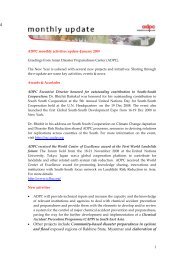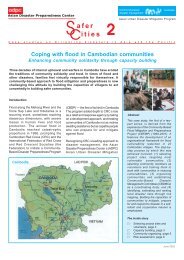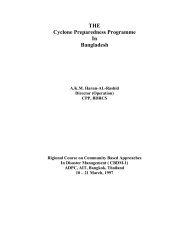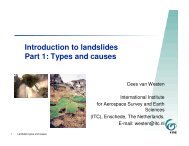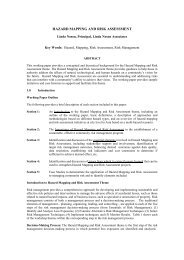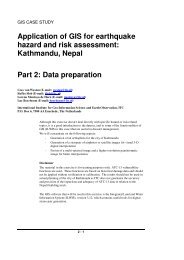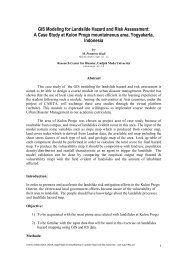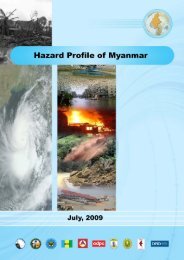community-based disaster risk management and the media media kit
community-based disaster risk management and the media media kit
community-based disaster risk management and the media media kit
You also want an ePaper? Increase the reach of your titles
YUMPU automatically turns print PDFs into web optimized ePapers that Google loves.
chapter 1. introduction to <strong>disaster</strong> <strong>risk</strong> <strong>management</strong><br />
• Damage to national infrastructure <strong>and</strong> disruption to governmental<br />
systems<br />
• National economic loss<br />
• Sociological <strong>and</strong> psychological after-effects<br />
Impact to Environment<br />
Disasters impact <strong>the</strong> environment in a number of ways: e.g. destruction<br />
to infrastructure (homes, buildings); decreased quantity <strong>and</strong> quality<br />
of water supply; destruction of agricultural crops <strong>and</strong> food stocks;<br />
increased mortality of livestock, wildlife <strong>and</strong> marine species <strong>and</strong> damage<br />
to <strong>the</strong>ir habitats; <strong>and</strong> <strong>the</strong> presence of unburied human bodies or animal<br />
carcasses. These impacts vary from <strong>disaster</strong> to <strong>disaster</strong>.<br />
Impact to Public Health<br />
The sudden onsets of <strong>disaster</strong>s cause not only widespread death but<br />
also injuries, outbreaks of epidemic disease <strong>and</strong> famine. Different types<br />
of <strong>disaster</strong> have different effects on health. Post-<strong>disaster</strong> potential<br />
health <strong>risk</strong>s do not occur at <strong>the</strong> same time. Instead, <strong>the</strong>y tend to arise<br />
at different times. Casualties occur mainly at <strong>the</strong> time <strong>and</strong> place of<br />
impact <strong>and</strong> require im<strong>media</strong>te medical care. Earthquakes regularly<br />
cause many injuries requiring medical care, while fl oods, storm<br />
surges <strong>and</strong> tsunamis cause relatively fewer injuries but may cause<br />
secondary effects such as an epidemic due to population movement<br />
<strong>and</strong> environmental changes. However, <strong>the</strong> <strong>risk</strong>s of increased disease<br />
transmission take longer to develop <strong>and</strong> are greatest where <strong>the</strong>re is<br />
crowding <strong>and</strong> reduced st<strong>and</strong>ards of sanitation.<br />
Economic, Social <strong>and</strong> Political Impacts<br />
Disasters disrupt economies. After a <strong>disaster</strong>, normal economic activities<br />
are severely curtailed; people must leave <strong>the</strong>ir jobs <strong>and</strong> devote <strong>the</strong>ir time<br />
to <strong>disaster</strong>-related activities, such as evacuation, search <strong>and</strong> rescue, or<br />
to <strong>the</strong> care of survivors <strong>and</strong> victims. Most often, in poor communities,<br />
whole livelihoods <strong>and</strong> houses are destroyed, <strong>and</strong> <strong>the</strong> basic necessities<br />
like food <strong>and</strong> shelter will be lacking. Oftentimes, for poor households,<br />
<strong>disaster</strong>s bring about more poverty. On a larger scale, whe<strong>the</strong>r or not<br />
an economy can recover quickly depends on <strong>the</strong> losses sustained.<br />
7



